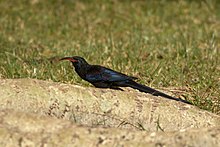| Black-billed wood hoopoe | |
|---|---|

| |
| A Black-billed Wood-hoopoe in Bishangari Lodge, Ethiopia | |
|
Scientific classification
| |
| Domain: | Eukaryota |
| Kingdom: | Animalia |
| Phylum: | Chordata |
| Class: | Aves |
| Order: | Bucerotiformes |
| Family: | Phoeniculidae |
| Genus: | Phoeniculus |
| Species: | P. somaliensis
|
| Binomial name | |
| Phoeniculus somaliensis (
Ogilvie-Grant, 1901)
| |
The black-billed wood hoopoe (Phoeniculus somaliensis) is a species of bird in the family Phoeniculidae. It is native to eastern Africa where it is found in wooded and scrubby areas.
The black-billed wood hoopoe is very similar to the green wood hoopoe (Phoeniculus purpureus) in appearance, but lacks the greenish gloss on the head and mantle and has a black beak rather than a red one, though there is sometimes a reddish tinge at the base of the beak. The sexes are similar and the adult bird is about 37 cm (15 in) long. The plumage is generally black with a bluish or purplish gloss, and a row of white spots on the flight feathers giving a white bar on the wings in flight. The long, graduated tail has white spots at the edge. [2]
It is found in eastern Africa, its range including Djibouti, Eritrea, Ethiopia, Kenya, Somalia, Sudan and South Sudan at altitudes of up to about 2,000 m (6,600 ft). [1] It is a bird of woodland, scrubby areas, forest edges, and gallery forests, and among large trees such as Acacias growing in wadis. [2] [3]
The black-billed wood hoopoe feeds on arthropods, millipedes, beetles and other invertebrates, foraging on trunks and branches by creeping along the bark, sometimes upside-down, and probing into crevices. It breeds in holes in trees. [4]
The black-billed wood hoopoe is a common bird and has a very wide range. Its population trend has not been quantified but it may be decreasing because the large trees in which it nests are becoming more scarce as a result of being harvested. No other particular threats to this bird are known and the International Union for Conservation of Nature has assessed its conservation status as being of " least concern". [1]
- ^ a b c BirdLife International (2016). "Phoeniculus somaliensis". IUCN Red List of Threatened Species. 2016: e.T22682678A92956165. doi: 10.2305/IUCN.UK.2016-3.RLTS.T22682678A92956165.en. Retrieved 12 November 2021.
- ^ a b Terry Stevenson; John Fanshawe (2004). Birds of East Africa: Kenya, Tanzania, Uganda, Rwanda, Burundi. A&C Black. pp. 238–239. ISBN 978-0-7136-7347-0.
- ^ Aerts, R.; Lerouge, F.; November, E. (2019). Birds of forests and open woodlands in the highlands of Dogu'a Tembien. In: Nyssen J., Jacob, M., Frankl, A. (Eds.). Geo-trekking in Ethiopia's Tropical Mountains – The Dogu'a Tembien District. SpringerNature. ISBN 978-3-030-04954-6.
- ^ Ligon, D.; Kirwan, G.M. "Black-billed Woodhoopoe (Phoeniculus somaliensis)". Handbook of the Birds of the World Alive. Lynx Edicions, Barcelona. Retrieved 24 November 2016.
| Black-billed wood hoopoe | |
|---|---|

| |
| A Black-billed Wood-hoopoe in Bishangari Lodge, Ethiopia | |
|
Scientific classification
| |
| Domain: | Eukaryota |
| Kingdom: | Animalia |
| Phylum: | Chordata |
| Class: | Aves |
| Order: | Bucerotiformes |
| Family: | Phoeniculidae |
| Genus: | Phoeniculus |
| Species: | P. somaliensis
|
| Binomial name | |
| Phoeniculus somaliensis (
Ogilvie-Grant, 1901)
| |
The black-billed wood hoopoe (Phoeniculus somaliensis) is a species of bird in the family Phoeniculidae. It is native to eastern Africa where it is found in wooded and scrubby areas.
The black-billed wood hoopoe is very similar to the green wood hoopoe (Phoeniculus purpureus) in appearance, but lacks the greenish gloss on the head and mantle and has a black beak rather than a red one, though there is sometimes a reddish tinge at the base of the beak. The sexes are similar and the adult bird is about 37 cm (15 in) long. The plumage is generally black with a bluish or purplish gloss, and a row of white spots on the flight feathers giving a white bar on the wings in flight. The long, graduated tail has white spots at the edge. [2]
It is found in eastern Africa, its range including Djibouti, Eritrea, Ethiopia, Kenya, Somalia, Sudan and South Sudan at altitudes of up to about 2,000 m (6,600 ft). [1] It is a bird of woodland, scrubby areas, forest edges, and gallery forests, and among large trees such as Acacias growing in wadis. [2] [3]
The black-billed wood hoopoe feeds on arthropods, millipedes, beetles and other invertebrates, foraging on trunks and branches by creeping along the bark, sometimes upside-down, and probing into crevices. It breeds in holes in trees. [4]
The black-billed wood hoopoe is a common bird and has a very wide range. Its population trend has not been quantified but it may be decreasing because the large trees in which it nests are becoming more scarce as a result of being harvested. No other particular threats to this bird are known and the International Union for Conservation of Nature has assessed its conservation status as being of " least concern". [1]
- ^ a b c BirdLife International (2016). "Phoeniculus somaliensis". IUCN Red List of Threatened Species. 2016: e.T22682678A92956165. doi: 10.2305/IUCN.UK.2016-3.RLTS.T22682678A92956165.en. Retrieved 12 November 2021.
- ^ a b Terry Stevenson; John Fanshawe (2004). Birds of East Africa: Kenya, Tanzania, Uganda, Rwanda, Burundi. A&C Black. pp. 238–239. ISBN 978-0-7136-7347-0.
- ^ Aerts, R.; Lerouge, F.; November, E. (2019). Birds of forests and open woodlands in the highlands of Dogu'a Tembien. In: Nyssen J., Jacob, M., Frankl, A. (Eds.). Geo-trekking in Ethiopia's Tropical Mountains – The Dogu'a Tembien District. SpringerNature. ISBN 978-3-030-04954-6.
- ^ Ligon, D.; Kirwan, G.M. "Black-billed Woodhoopoe (Phoeniculus somaliensis)". Handbook of the Birds of the World Alive. Lynx Edicions, Barcelona. Retrieved 24 November 2016.
